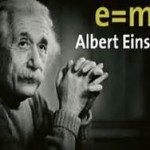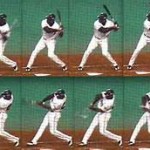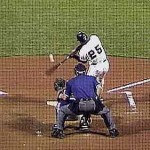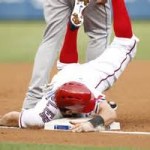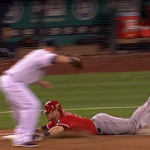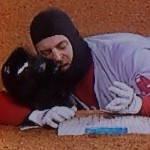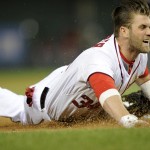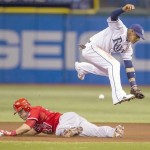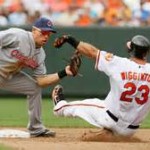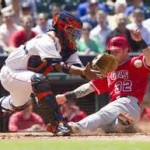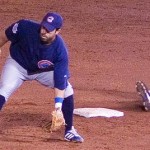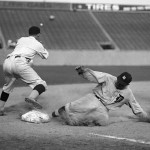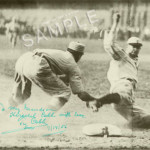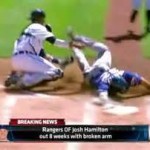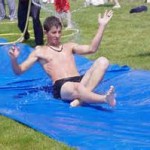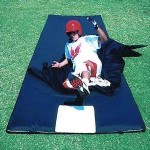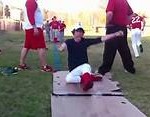Zeno’s paradoxes set the ancient Greek civilization and its subsequent derivatives into a philosophical conundrum that was not suitably explicated, to human reasoning, until Isaac Newton and others concocted and refined the mathematical system of Calculus to unlock these mysteries and lead to a natural, sequential rule for enlightening the understanding, with regard to everything the Universe’s Law of Attraction has to offer. Zeno was one of a goodly number of pre-Socratic philosophers (from 6th and 5th centuries B.C.) whose inquiries into mathematical computations influenced the philosophical discussions of his own and subsequent generations. The various philosophical schools dealt with a wide range of approaches to the discussion of nature:
The Ionion School espoused a physical apprehension of sciences, of air, water, fire, and earth. The Ephesian School, of Heraclitus, conceived the cosmos as a ceaseless pluralistic conflict of opposites. The Eleatic School challenged the cosmic flux of Heraclitus, with Parminedes’ view that the universe was one and unchanging, and that observed motion was merely an illusion. Democritus of Abdera and the Atomist School agreed that the universe was composed of tiny unsplittable particles, and a world totally mechanistic. And the Pythagorean School held the opinion of its founder, Pythagoras of Samos, that nature was written in the language of mathematics.
Zeno’s inquiry into the flight of an arrow simply amounted to a question of how the arrow manages its continuous flight since it, at any given point in its route, is in a fixed or stationary position? Newton’s Laws of Motion had not yet been discovered, but Greek philosophers and mathematicians like Archimedes, Euclid, and others (not to mention Pythagoras and Aristotle) extended their ideas toward expanding mathematical principles and theorems that eventually were contributing factors in the discovery of Calculus, by Newton and von Liebniz.
As the calculus principle became more clearly defined, and its Fundamental Theorem demonstrated the reciprocal relationship between the infinite processes of the Derivative and Integral concepts, previously incomprehensible and unanswerable mathematical and philosophical queries have come into the realm of reconciliation or atonement. Einstein’s “Relativity” Theories and the subsequent development of Quantum Mechanics were natural consequences of the Calculus facilitation. And of course, logical solutions to Zeno’s paradoxes have been forthcoming.
Calculus has provided a viable means to explain circumstances that appear to be unfathomable to the human mind and produce conditions that had been previously inconceivable. This hyper-cognitive human enhancement has further advanced the notion of an infinite resource from which the store of knowledge is inexhaustible, and to which man’s inherent capacity may have no bounds.
Zeno’s paradoxes provided a venue from which to promote critical analyses of conditions and/or circumstances to which there may be more than one perspective. If something appears inharmonious, wrong or deficient in substance, a clearer perspective may detect a device to alleviate or lessen the degree of error. If any number of combinations attenuate to the approximate substantial ease of the condition, then harmony is restored, a problem is solved, or relief is attained while resistance is decreased or eliminated. Calculus can be applied mathematically, philosophically, or even athletically to diminish the margin of error, and eventually lead to the precise answer to an enigmatic uncertainty (perhaps, even hitting a baseball efficiently).
One might consider Socrates to be a predecessor to Newtonian Calculus because of his efficient use of his Dialectic intercourse to promote the educational facilitation of all those with whom his instruction came into contact. When an interlocutor engaged in a dialogue with Socrates, a sequence of questions ensued which eventuated to a point of mental clarity, which had not been substantiated by the student’s previous demonstration of intelligence. At the conclusion of any dialectic intercourse, those individuals pragmatically involved in the discourse were benefited by increased knowledge and understanding of the various subject matter through the auspices of rational, sequential, thoughtful collaboration. Socrates reduced the students’ ignorance by logical progression of thought, which heightened their awareness of prospective attributions as well as obvious deficiencies. However, there were those who could not be beneficiary to Socrates’ dialectic teaching because they were unwilling to engage him, either because their foresight was too myopic to perceive the Integral of the “big picture,” or their resolve too impatient to extract from the Derivative a logical starting point (previous-life experience) from which to disembark out of mental stagnation.
If Zeno and Socrates are presented as progenitors of the dialectic precursor to Newtonian Calculus, Plato must be their immediate successive contributor in the arena of poetic stimulation for thought provoking enhancement to enlarged perspective. Metaphor and Trope illuminate the tapestry of Plato’s voluminous writings. Yet he beguilingly submits a decree to ban poets from his Utopianistic society if the higher essences of being are not illustrative of their artistry in stead of their mundane, twice-removed mimeses of substantive reality or Truth.
The true sense of Poetry deservedly appropriates a contributable share of functionality toward universal enlightenment, due to its uncommon vernacular and elevated perspective that provide more than an alternative view to the curious or soul-searching audience. Those who are lost, as well as they who need daily sustenance to maintain sobriety, should be nourished by the bread and wine of divinely inspired poetics. A verse or three, which delicately translates a one celled organism into a microcosm of universal accommodation, readily could transform a desperate, societal dysfunctional into a sober, appreciative, community asset, by awakening him to his present primordial status, but with advancing hope to his prospect for significant accountability.
Einstein’s Relativity theories brought to light many illuminating facets that implemented a modern civilization by means of Calculus. His Photo-Electric Effect precipitated the Quantum revolution whose statistical analyses proposed new venues through which to extrapolate the energies from an exhaustless universe. His examination of the universe, with relationship to light, proved the electro-magnetic properties of wave and particle allowed light to travel in a straight line, but because of the gravity-warped universe, the curvature of light was prominently evidenced. There seems no end to what humanity can accomplish through the gradual, sequential thought expansion brought about through reason and revelation.
Civilization has advanced humanity, as a whole, into what is now the third millennia since the onset of its flawless prototype manifested itself in the form of a man, who was the embodiment of all lasting achievements that the subsequent world was ultimately to discern, after lengthy trial and error. Without ever writing down a word on paper, he elucidated, to a darkened world of fundamental ignorance, the absolute truth of being, through his elevated thought, his inspirational and authoritative speech, and his incomparable, but mystifying demonstrations of spiritual power. Never before was a man imbued with such a complete understanding of the intricate inter-dependency of all that make up the fabric of universal humanity, as well as elements (physical, mental, and vibrationally spiritual) that comprise the interior and exterior manifestation of the world itself.
His method of instructing the young, poor, and needy superseded even the proficient dialectic of the noble Socrates, by supplanting the philosopher’s idea of physical and mental evolvement by means of “recollection” of past lives’ experiences, with superlative recognition that, as children of Supreme Source, we have always been the recipients of infinite spiritual resources, with which to exhibit vast intellectual prowess, superb physical adroitness, and unadulterated moral fiber. His poetic, prosaic parables, fraught with love, compassion, and resolvent, captured the hungry hearts and receptive minds of small and large audiences, of whose barren lives were unmistakably rejuvenated by the power that resonated from his and their very soul. And his acute sense of judicious interjection curtailed many an ambitious enterprise by hostile mobs, self-consumed with violent intent: upon a forlorn adulteress about to be stoned, a repentant sinner at a formal dinner, a seditious rally before wary soldiers of Caesar’s. Only words that would emanate from a divine Source were capable of melting the hardened hearts of these mal-content: “Let him who is without sin among you, first cast a stone at her”; “to her who loveth much, much is forgiven”; and, “render to Caesar the things that are Caesar’s, and to God, the things that are God’s.” Was even a Plato or Shakespeare more adept than Jesus of Nazareth at evoking a verse that would compel the restraint to a rampant stampede?
Not only did his words exude from meaningful thought to ponder, and from which to be encouraged to repent and mentally reform, but also they elicited a power which entitled the earnest adherents, to their exact meaning, the benefit of extrapolating the substance from which they experienced physical and moral reformation. Jesus went beyond Philosophy, Calculus and Quantum Physics to translate the health-giving properties of light into the essences of their corresponding qualities of life (In him was light, and the light was life of men). The correlation of universal principles have always been present, just not cognized for delineation and application. The two ideas of Calculus, the Derivative and the Integral, are always available to be applied in scientific unity, as they are dependent on each other to promote individual and collective facilitation. Jesus’ understanding of himself as “derived” from Source fulfilled every aspect of his relationship with Goodness, as “integrated” into the Whole. Every aspect of his being was ensconced in perfection. Therefore, his scientific understanding deterred any prospect of his being or becoming imperfect. The Law of the Universe includes all the laws of physics and mind and nature. Jesus had at his disposal the entire law of Goodness, therefore, including all the law. Jesus didn’t need to comply specifically with the laws of matter, etc. because he abode within the higher law, which encompassed the lesser laws. When Jesus healed invalids instantaneously, he evoked the law of Infinite Mind to superimpose itself over the laws of matter. When he walked over the water, walked through walls, healed the blind from birth, healed the centurion’s servant and the son of a nobleman from a distance, brought fresh life instantly to the decrepit, the leper, the palsied, the dying, and the dead, he solicited not any superficial material law, but rather the superlative declaration of Spirit, which verified “Quantum’s” hypothetical prospect of “tunneling” and “connectedness” under uncertain circumstances, involving instantaneous and distant transmission.
Jesus’ early followers, who were privy to a closer and more intense perspective of his inherent, natural application of Spiritual Law, found it less difficult, than do our contemporary advocates, to accept and abide in an eager willingness to duplicate his acts of uncommon facility. In the early stages of what eventually became known as Christianity (followers of Jesus, but adherents to the Christ, of which Jesus was the embodiment), necessity and dire need accentuated the purposeful intent for collective edification. Reliance on a Supreme Source of sustenance was critical during this time when dependency upon mere humanity was tenuous at best. Individual demonstrations of Christly proficiency abounded, and, because of their frequent exemplification, converts to the newly founded Community of Enlightened thought were rapidly forthcoming. And so, Christianity, while strictly abiding by the Principle which Jesus set forth in his teaching and demonstrations of Absolute Truth, eventually became prosperous, because its abidance within Spiritual accommodation superseded any intent to abide in the limited and limiting world of material superficiality.
Calculus and Quantum Mechanics had not yet been specifically delineated, but Jesus, and those who better understood their prospective relationships to the Whole, derived an integral of function for every aspect of the human condition. When Jesus replied to Pilate, before his crucifixion, “For this purpose was I born, for this cause came I into the world, to bear witness to the Truth.” he more than implied to human interest that he was the “way-shower” of Joy and Happiness (not sorrow)for all mankind. His own quantum leap, beyond the material confines of mortal thinking and circumstances, provided a means for all astute advocates of the same simple rule of Spirit to advance beyond their own limited sense of “things,” into the Vortex, in Which and of Which are all good things .
Unfortunately, for Christianity, and mankind in general, after the onset of notable prosperity, and with a vanguard of rigid doctrinal behest, upon Constantine’s dubious acclamation of Christian priority, the essence of true Christliness diminished from the individual character of what was once the hallmark of spiritually effectual evidence. Although pockets of demonstrable facets of the original constituent would still spark impulse for future recollection (miracles), sparse were demonstrations of true Christianity in a sectarian world, until their practical resurgence in late nineteenth century.
In the late 1800s, just before outstanding seminal scientific accomplishments made possible Einstein’s (and others’) flowering historical achievements, a New England woman was stirring up a metaphysical elixir that was soon to afford spiritual consciousness a renewed interest for those searching for a viable alternative to the onslaught of ultimate material mechanization. She came onto the world’s scene with the publishing of her metaphysical textbook, later revised to be titled, Science and Health, with Key to the Scriptures, a few words from which read as follows: “As the crude footprints of the past disappear from the dissolving paths of the present, we shall better understand the Science which governs these changes, and shall plant our feet on firmer ground.”
Mary Baker Eddy, as she was known in later life, endured the calculus of intervening years of “derivation” before realizing the integrated spiritual consistency between generic man and their Creator, the Source of all being. The hardships, that seemed to precede her own revelation and subsequent harmonious co-existence with Eternal Truth, actually conspired to their own ephemeral and baseless nature in mortal existence, and ultimate demise from her experience. Her astute analyses of the material world might be summed up with these words from her textbook, “Material substances or mundane formations, astronomical calculations, and all the paraphernalia of speculative theories, based on the hypothesis of material law or life and intelligence resident in matter, will ultimately vanish, swallowed up in the infinite calculus of Spirit.”
As the stimuli of ever-advancing enlightened thought precipitated into the 20th century, luminaries in varying degrees graced our shores with timely introductions to new waves of powerful and thought provoking ideas to stir the stagnant mental river-beds of complacent generations to even more innovative means to garner the inexhaustible fruits of Source. Jane Roberts and her “Seth Books,” and Helen Schucman’s Course in Miracles gave to inspired seekers two new different approaches with which to view the world. And finally, the discovery and development to human awareness of the ever-expanding concept of the Law of Attraction by Jerry and Esther Hicks brought the world to the attention of Abraham, whose Non-Physical community of Vibrationally stimulating forces have directed Esther to reveal the “leading edge” criteria for further expanding the perpetual advancement of Mankind as well as the Universe Itself.
Zeno, Socrates, Plato, Galileo, Newton, Einstein, and others have inter-dependently combined to express the derivative and integral for deliberate enhancement of our continuously advancing human history. But, as Einstein and Quantum physics verify, “at the fundamental level of matter, causation is a matter of statistical probabilities, not certainties.” Therefore, those mightiest of scholars fell short of their greatest expectations because absolute understanding is unattainable through the direct study of matter. “Spiritual rationality and free thought accompany approaching Science and cannot be put down. They will emancipate humanity, and supplant unscientific means and so-called laws,” states Mrs. Eddy.
Expansion of human reason is a noble goal for human involvement, but the science of the Christ gives us pellucid access to Divine thought. Again, Mrs. Eddy expounds, “A knowledge of the Science of being develops the latent abilities and possibilities of man. It extends the atmosphere of thought, giving mortals access to broader and higher realms.” All material ideas will grow old with the onset of more enlightened thinking. But the speed by which these new ideas make themselves manifest is ultimately decided by the attenuation of materially induced resistance by superimposed spiritual unfoldment of Good-thoughts. Mrs. Eddy writes in her Miscellaneous Writings, “Science is neither a law of matter nor of man. It is the unerring manifesto of Mind, the law of God, its divine Principle. Christian Science translates Mind, God, to mortals. It is the infinite calculus defining the line, plane, space, and the fourth dimension of Spirit. …In Science all being is individual; for individuality is endless in the calculus of forms and numbers.”
Jesus, Mary Baker Eddy, and Abraham-Hicks were/are extremely proficient practitioners of the Science of the Source, capable of healing not only sickness and disease, but every discordant or fraudulent condition that a being could possibly encounter. Their basis for healing was/is the Calculus of Eternal Mind, from which the Integral of Love was ultimately the infinite process by which the computation of Health or concord was instantaneously “derived” at a point of Spiritual recognition. They heal(ed) instantly when they don’t have to banter with uncertain mind forces, but only gently apply Love’s balm to those receptive and faith-full respondents to infallible Truth.
Hope and Faith are essential to Love’s bequests. To envision fruitfulness to its present fulfillment entails a doubt-free expression of mental commitment. Jesus, Mrs. Eddy, and Abraham-Hicks all assure that “all things are possible to Source”, and the human condition facilitated the application of Source’s Love. Mrs. Eddy’s statement from Science and Health, covers most of the ground and substantiates biblical record for Jesus’ feeding the multitudes with a pittance of material resources, with these words: “Necessity (for uplifting the race) is father to the fact that Mind can do it.” Whether for “uplifting the race,” or for caring for any man’s daily need, Divine Mind can, and will, do it! But the Science of that Mind must be understood and practiced by those who would benefit from their Source’s own Benevolence. The Bible saying, “God hath spoken once; twice have I heard this, that power belongeth unto God,” is certainly fulfilled in our ears and our demonstrations, if we accept and take advantage of the exemplary teachings and works of our prominent predecessors to actively applying the Truth of being.
Babe Ruth, Ted Williams, Mickey Mantle, Barry Bonds, Socrates, Plato, Shakespeare, Galileo, Newton, and Einstein all did remarkable things that warrant respect and appreciation for their individual contributions to human history’s advancing civilizations. However, the estimate of their worth is analogous to the tip of the tip of the largest iceberg when compared to the other 99% that is not even broad enough to equate to the inestimable contributions of Jesus, Mary Baker Eddy, and Abraham-Hicks for the edification of all mankind. The vision of a peaceful planet, in the future, is now, to those whose consciousness is predisposed to the eternity of infinite Truth and Life!
In late nineteenth century, before space travel became a probability, Mrs. Eddy implanted these words in her textbook, with reference to the prerogative of Infinite Mind, “ The seasons will come and go with changes of time and tide, cold and heat, latitude and longitude. ‘As a vesture shalt Thou change them and they shall be changed.’ The astronomer will no longer look up to the stars, — he will look out from them upon the universe; All we correctly know of Spirit comes from Source, divine Principle, and is learned by/through/of His expressed Likeness and the Image Thereof.”
AND HOW DOES THIS APPLY TO BASEBALL?
THIS applies to EVERYTHING; and Baseball is certainly included within that Concept of Everything! You only need to THINK about it. You’ll be hearing more.
